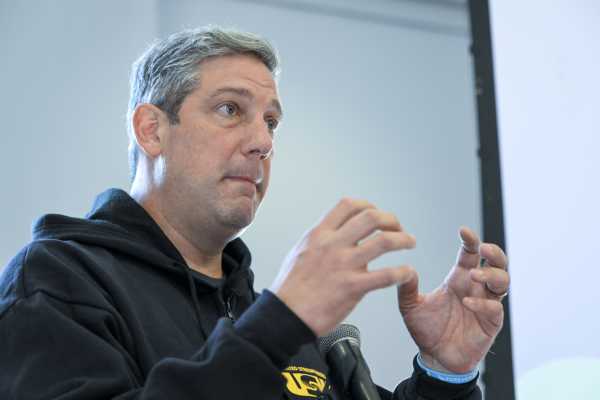
Ohio was once the fulcrum of American politics. For most of the first two decades of the 21st century, it was the pivotal swing state. John Kerry’s narrow loss there in 2004 caused the reelection of George W. Bush. In 2012, Fox News viewers watched, stunned, as the state was called for Barack Obama, dooming the hopes of challenger Mitt Romney.
After Donald Trump won it twice by eight points, its status as a swing state has been called into question. The only remaining statewide elected Democrat is three-term senator Sherrod Brown, while Republicans, aided by precise gerrymanders, have maintained an iron grip on the state legislature and the congressional delegation.
In recent months, though, the state’s Senate race has captured the imagination of national Democrats. The Democratic nominee, 10-term Congress member Tim Ryan, has mounted a surprisingly strong race against the Republican candidate, Trump-backed author J.D. Vance, and has kept the race close in public polling. Ryan enjoyed a strong summer when Democrats were surging in national polls and Vance was off the airwaves recovering from a brutal primary. Currently, FiveThirtyEight gives Ryan a one in four chance of prevailing while the longtime representative is bewailing the lack of investment from national Democrats. Does Ryan have red a chance? Or is he a forlorn hope in a Republican-leaning state in a Republican-leaning year?
What Ryan has going for him
First and foremost, the race is close. Polling in Ohio consistently has Ryan within the margin of error against Vance. As Justin Barasky, a top strategist on the Ryan campaign, told Vox, “It’s not like there are a bunch of polls showing Vance in the 50s, and there’s no question Tim has to win over folks who are voting for [Republican incumbent Mike] DeWine for governor and [has] clearly been doing that.”
Most observers acknowledge that Ryan has been running a strong campaign. Danny O’Connor, the Franklin County recorder and a former congressional candidate, hailed Ryan’s chops on the campaign trail and his effective pitch to voters as a moderate populist supportive of a more protectionist trade policy. “For him to cut through in a state with so many media markets, you have to be a compelling candidate. He put the work in, has a message, and that message moves voters.”
O’Connor and Barasky both jabbed at the campaign Vance was running, arguing that the author and venture capitalist had failed to connect with voters; they both noted how reliant the Ohio Republican was on outside money from groups like the Senate Leadership Fund, a Mitch McConnell-aligned super PAC. In contrast, buoyed by MSNBC appearances and a fire hose of small dollars encouraged by viral Twitter clips (like the recent scripted moment in a debate where he told Vance that “you kiss [Trump’s] ass”), Ryan has raised nearly $40 million. That’s an eye-popping total for a Senate campaign in a midterm election, and trails only Democrat John Fetterman in Pennsylvania among 2022 Senate candidates.
O’Connor also expressed skepticism about just how Republican Ohio is. “I think it’s more Trumpy,” he said. He pointed out that, although Trump won the state twice, “normal Republicans never really won it by much.” In particular, he noted that, in 2018, Mike DeWine only won the election by 3 percent, albeit in a Democratic wave year, when Brown won reelection by 7 percent.
Vance has also stumbled as a first-time candidate. National Republicans have griped about the amount of outside money they’ve needed to spend in the state to bail him out after he faced a long, ugly, and expensive primary. Democrats and Republicans agree, though, that he was still a better bet for the GOP than Josh Mandel, the former state treasurer who finished second in the primary. In contrast, Ryan cruised to the Democratic nomination and did not face serious opposition.
Where Ryan runs up against tough political realities
For Luke Thompson, who runs the pro-Vance Protect Ohio Values super PAC, the race comes down to two numbers: 39 and 45. “Thirty-nine is roughly where Joe Biden’s approval is in the state, and 45 is where Tim Ryan is stranded in neutral in all of the public polls.”
Thompson likened the campaign to a Senate race in Iowa eight years ago. Then-Rep. Bruce Braley was locked in a tight race against then-state Sen. Joni Ernst. The polls showed a tight race throughout but never showed Braley hitting 50 percent. On Election Day, undecided voters broke overwhelmingly for the comparative unknown over the Democratic congressman, and Ernst won by 9.
Thompson and other Ohio Republicans who spoke to Vox also pushed back on the notion that Ryan’s campaign had been maximally effective. One adviser to the Vance campaign, who was granted anonymity in order to speak frankly about the campaign, argued that Ryan’s attempts to paint himself as a pragmatic moderate didn’t line up with his voting record in Congress, where he voted as a party-line Democrat. Ryan also espoused far more progressive rhetoric during his abortive 2020 presidential campaign on issues like criminal justice.
The Vance adviser argued that strategy was doomed to failure once it was contested on the air, in ads and messaging indicating Ohio voters saw that he legislated like a typical Democrat, and that no quantity of additional outside spending would make much of a difference at this point. He also noted Ryan had shifted from message to message through his campaign and seemed hesitant to fully commit to either running a race that would appeal to the suburban voters who have been trending toward Democrats or to wooing the blue-collar voters who have been moving away in the Trump era.
And despite the amount of money Ryan raised, the Ohio Republican had nearly $2 million more on hand at the end of September.
None of that means anyone thinks Ohio was now unwinnable for Democrats, even as it shifted to the right. But Thompson noted that, in the hierarchy of swing states, Ohio was “redder than North Carolina and perhaps redder even than Florida.”
By any conventional standard, Ryan is the underdog
There’s little reason to think there will be any change in the historic pattern this year, where there’s backlash against the party in power in a midterm election. Democrats have four incumbents facing tough reelections in states that Joe Biden won (Arizona, Georgia, Nevada, and New Hampshire) and two more Democrats running for Republican-held Senate seats in Biden-won states (Pennsylvania and Wisconsin). In addition to that, there is the open Senate race in North Carolina, a state with a Democratic governor, where Trump only won by 1.5 percent in 2020.
Republicans are relatively confident as voters focus more on the economy and rising inflation. As the Vance adviser noted, “the abortion issue maxed out a few weeks ago” and isn’t as potent an issue in Democrats’ favor in the home stretch as it was over the summer. There was a sense that Ryan had hit his ceiling in polling.
O’Connor was still confident that Ryan was in good shape as “a classic retail politician,” in contrast to Vance, a first-time candidate. He thought Ryan could appeal to the pragmatic streak in voters in a state where many would be splitting their ticket. “Ohioans like people who put the ball in the end zone,” he said.
However, in a conservative-leaning state like Ohio, that probably won’t matter: Its recent rightward swing and electoral demographics mean every Republican there is spotted a lead.
Will you support Vox’s explanatory journalism?
Millions turn to Vox to understand what’s happening in the news. Our mission has never been more vital than it is in this moment: to empower through understanding. Financial contributions from our readers are a critical part of supporting our resource-intensive work and help us keep our journalism free for all. Please consider making a contribution to Vox today.
Sourse: vox.com






